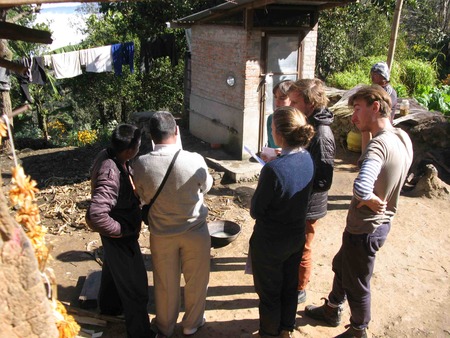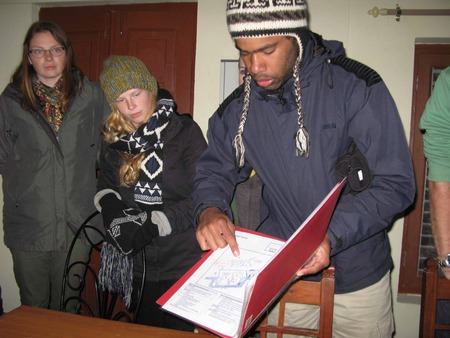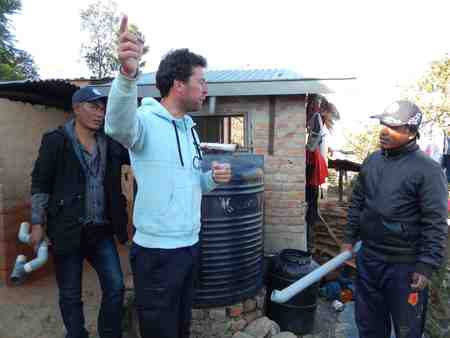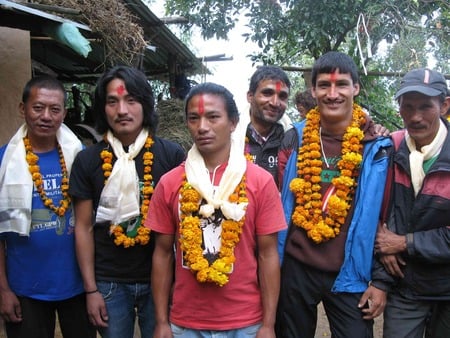Design for those who need it most – lessons from the Nepal Sanitation Studio 2014
Poor people need the very best design for one simple reason – it is essential for their survival – they have few options.
Design alchemy transforms mediocre, leaden design into award winning design gold. But this magic trick only works for a brief period of time and as fashion and style move on, the tool, product or building reverts into a design pumpkin at midnight. And as thousands more new and improved designs are created, we simply move on.
So how does this relate to the Sanitation Studio in Nepal?
The Village Sanitation Program in Nepal was been designed to improve health, and that means all the parts that make the program work – the buildings, all that lies beneath the ground, the people and the ongoing maintenance – have to function. As there are no options up or down the steep hills of the poorest villages, it not only has to work, it must keep working. This requires the very best design, construction and ongoing, locally organised maintenance.
The architecture students and plumbers that came to the 2014 Studio began the week seeing the toilet as a simple building with perhaps a slightly poorer standard of finish and fitting than they normally encounter back home. They left the Studio, having learnt not just about the above ground structure that can be photographed but also about all that sits below ground to treat the waste water and render it safe for disposal and they learnt about the local people who make the Program happen.
All the projects run during the Sanitation Studio contributed to the ongoing development of the Sanitation Program. They were able to fit into a strong existing local structure and history of the work.The visitors did not come to build toilets and take jobs from the Nepali team already employed and skilled. They came to add their design, trade and teaching skills to the local team and the future improvement of the Program.
Everyone worked hard on important pieces of the puzzle and everyone learnt first hand about the complex matrix of design, construction, social, environmental, economic and health links that are embodied in the program.
We all learnt urgency.
Urgency is perhaps not a desirable trait in a Bhuddist community, but the work done by the students and the plumbers was real, it was needed and needed immediately. For health gain, the design work and the need for better design and function was not optional, it was essential.
The design process continues.
We all learnt that design or construction faults have important consequences and need new design thinking.
- Last year, the plumbing team joined plastic pipes (in the construction of the rainwater diverter systems to improve water quality) without using a primer before using the jointing glue. Only a year later, the connections on the 4 trial systems were loose. They were fixed, but without attention the system would have failed and water quality diminished. How to better joint the pipes, with locally available materials?
- The toilet door metal lining material is not strong enough to withstand the robust kids and in some toilets after 5 or 6 years, this leads to small holes that may compromise privacy and maybe toilet use. How to strengthen the door, reduce cost and make even healthier kids?
- The washing area near the outside toilet tap, initially designed for the essential hand washing after using the toilet, has proven so popular that it is now used additionally for dish and pot washing, toothbrushing, filling cooking pots and filling clothes washing tubs. There are obvious conflicts between some of these activities and a modified design is needed for what appears to be a very simple area near the toilet.
- Applying pipe fixing glue using what is at hand – a finger – and not a applicator brush, seemed harmless enough. But when one of the visiting plumbers has had experience in toxic materials and the harm they do, he intervened to explain the route of the chemicals throughout the skin into the body. The local team understood the story, made a bamboo brush and the problem was solved.
Many types of design work improved the ongoing Village Sanitation Program.
The design of the Maintenance Manual helped local teams complete thorough maintenance tests of the systems, order materials and then initiate repairs. The system developed in the Studio was put into use the following week and has already generated maintenance work and repairs. This will also provide a model for upcoming work in South Africa.

The Construction Manual will be an invaluable tool as the program spreads regionally in Nepal, allowing local construction manager’s to report on progress and ensure build quality.

The Plumbing Works completed retro-fitting to 16 toilet roofs to ensure better quality drinking water in the local tank. The training done by the two visiting plumbers have embedded good design and construction practice and this will remain in Nepal as the teams continue the retro-fit work.

The filmmaker was busy designing how the stories about the program could be told. He is now doing final edits that will describe the Sanitation Program – the place, the local people, the technology, the supporters of the program and how the combination of all of these makes for health gain.
Hopefully these stories will inform and inspire by showing how simple changes can improve the living environment and the health of those for whom the best design is not a fashion statement, but a necessity.

the Nepali construction team
Thanks, as always, to all those who gave their time and energy to the Studio, the on ground NGO and construction teams who helped run the Studio, the supporters who help make it all happen and the participating villages that welcome us all into their homes and families with such generosity.









